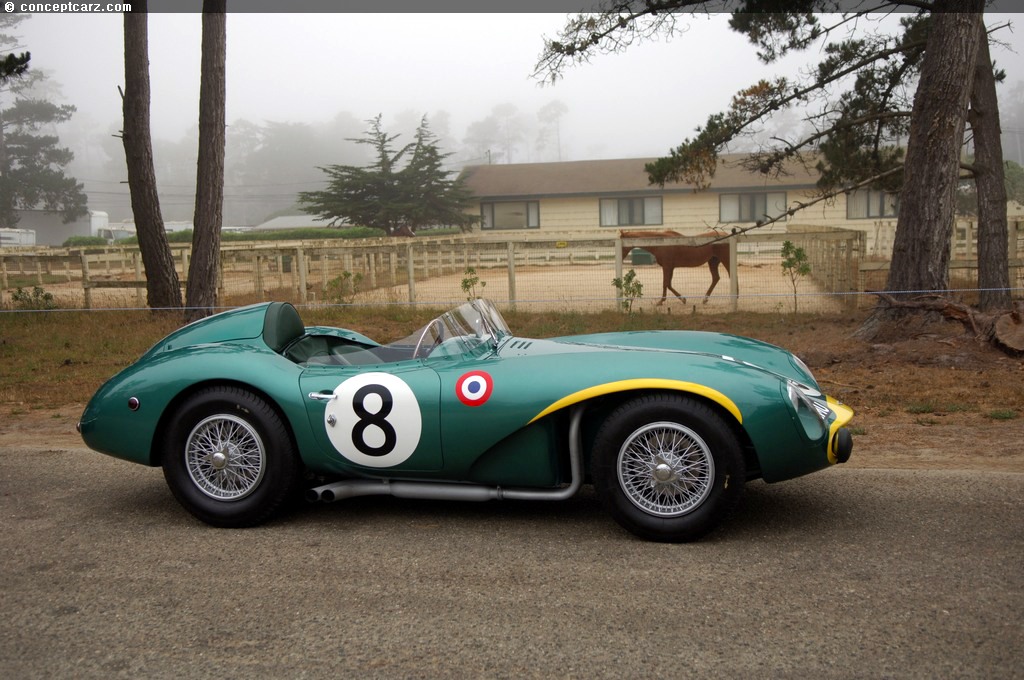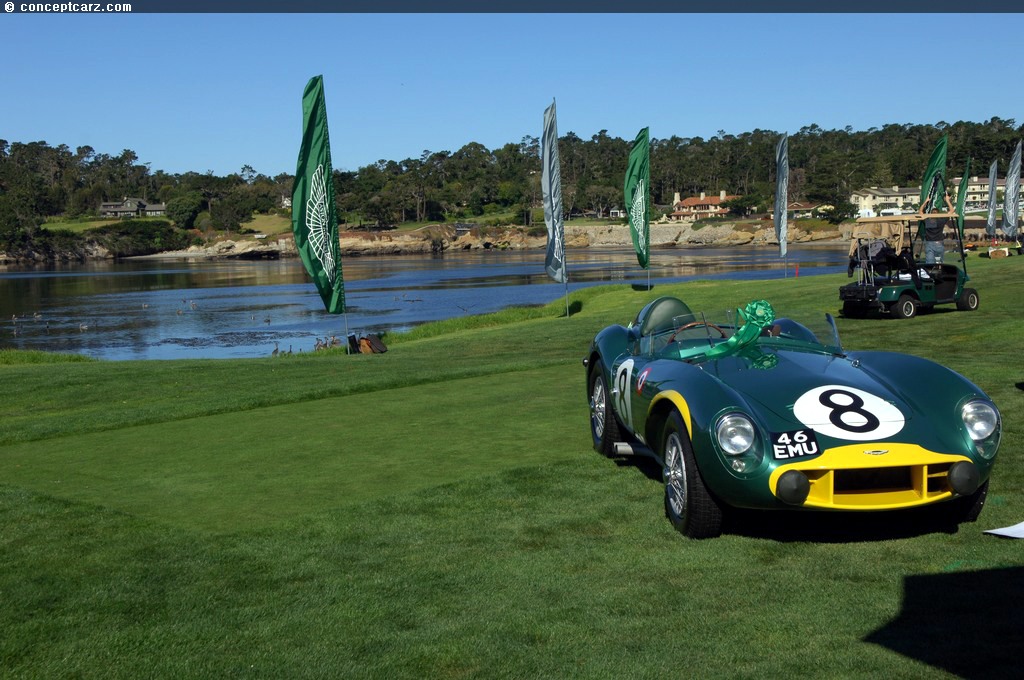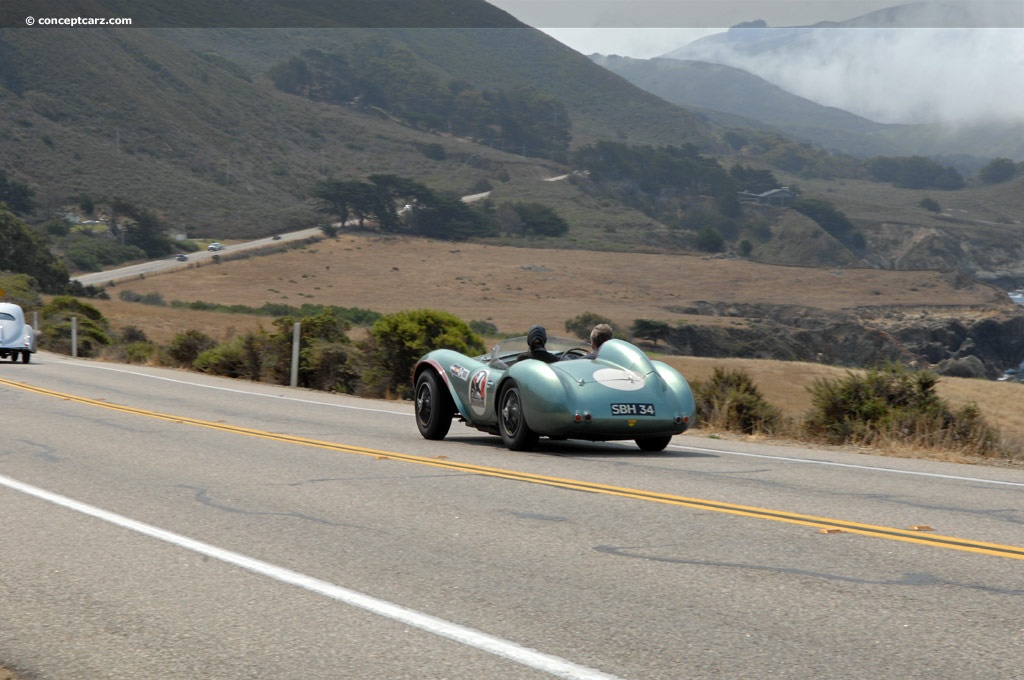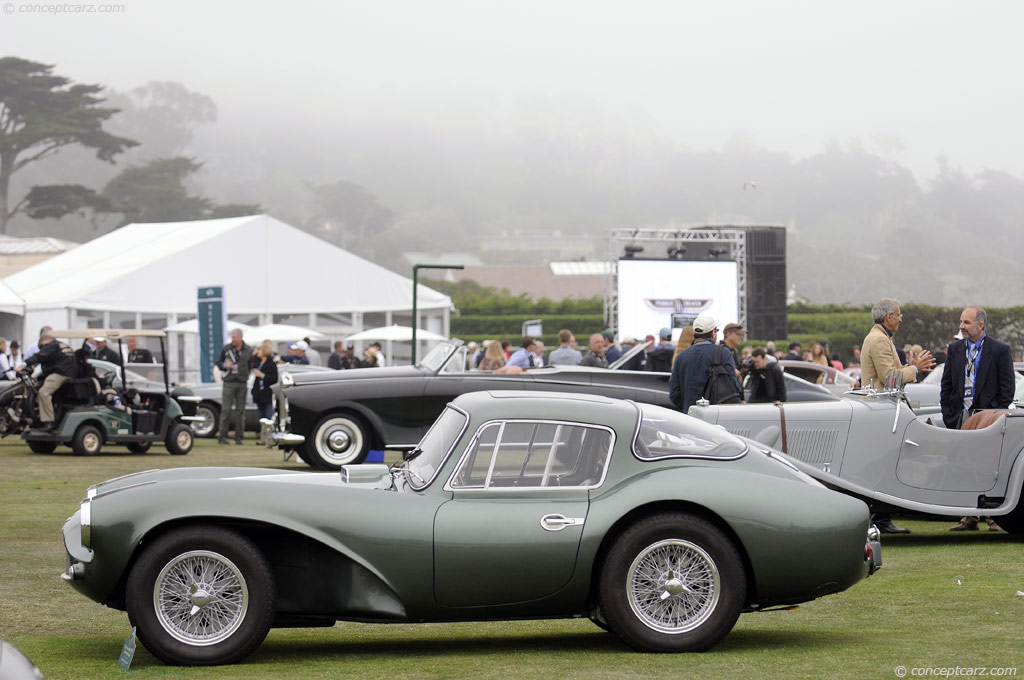The Aston Martin DB3 represented the pinnacle for British high-performance sports car racing during the early 1950s, combining the graceful and tasteful body styling, mechanical sophistication courtesy of Dr. Robert Eberan von Eberhorst, and a potent W.O. Bentley-designed twin-cam, 2.6-liter, six-cylinder engine. Its 'DB'-series model title is derived from the initials of northern English gear and machine-tool industrialist David Brown, who acquired the already famous Aston Martin sports car marque in 1947. 
Roadster
Chassis #: DB3S/9
View info and historyIntroduced in 1951 as the DB3, its 2.6-liter engine quickly proved underpowered, so a larger 2.9-liter version was introduced in June 1952. The DB3S of 1953 was even lighter, more nimble, and equipped with the high-compression 3.0-liter version of W.O.'s straight-six.David Brown wanted to win the 24 Hours of Le Mans, and the DB3 was his first purpose-built weapon, which had some success but, on most outings, was not competitive. It was designed for Mr. Brown by German engineering director Dr Robert Eberan von Eberhorst. The twin-tubular chassis had a wheelbase size of 93 inches (2,362mm), a height of 40 inches, and an overall length of 158.5 inches. The front suspension used a torsion bar and trailing arms while the rear DeDion axle used torsion bars, a Panhard rod, and parallel links. DB3S : Mechanical Specification
William Watson was Eberhorst's assistant, and recognizing a weakness of the DB3's design, he approached Aston Martin's competition director, John Wyer, with a solution. He proposed to make the tubular chassis more compact, with its short dimensions having a wheelbase size of 87 inches and an overall length of 154 inches.
Roadster
Chassis #: DB3S/9
View info and historyComplementing the lighter specification, the Lagonda straight six's bore increased to nearly three liters (2,992cc) and the early twin OHC setup later gave way to a twin-plug head. Initially offering 182 horsepower, the twin-spark version with three twin-choke Weber 35 DCO carburetors produced upwards of 225 bhp by the end of its DB3S' career. Power was sent to the rear wheels via a David Brown four-speed transmission, and drum brakes provided the stopping power. The Salisbury hypoid-bevel final drive of the DB3 was replaced with a David Brown spiral-bevel version. It was the hypoid spiral drive that retired two DB3s at Le Mans in 1952.In-house stylist Frank Feeley created the body design for both the DB3 and DB3S, but they were completely different. The DB3 wore a chunky, slab-sided body, while the lines of the DB3S were more refined, flowing and svelte. Built using aluminum, styling elements included a cutaway section behind the front wheels (later adopted by the Ferrari 250TRs) and a 'humped oval' grille theme. Racing Debut
The Aston Martin DB3S made its racing debut in May 1953 at Charterhall, where Reg Parnell defeated the Ecurie Ecosse C-Types. Le Mans was the next event and it would be - ironically - the only race that Aston Martin lost in 1953. Reg Parnell crashed a DB3S (chassis DB3S/2) before Peter Collins could take over driving duties, and another team car retired due to ignition failure. After LeMans, the team won the Tourist Trophy (1st and 2nd place) at Dundrod, Goodwood Nine Hours (non-championship round), and the British Empire Trophy. Aston Martin finished the season 3rd in the championship.
Roadster1954
The 1954 championship season was a disappointment, with the exception being at the Buenos Aires 1000 km, where the team finished third. For Le Mans, the team created a unique, low-drag body for the high-speed circuit. Leaving nothing to chance, the experimental car was also given disc brakes at the front and a supercharger. A V12-engined version was also developed but did not bring the team the desired result. The fixed-head coupe bodies were intended to make the car more aerodynamic, but they proved to be unstable at high speeds, and both coupe-bodied examples crashed at Le Mans. These two cars were later given open coachwork.1955
Despite the team's struggles in the 1955 season and lack of success, there was enough demand for a customer version that the factory began selling the DB3S in 1955. The 'Works' and 'Customer' cars were similar in many details, but the latter had a three-digit chassis number and a single spark ignition engine breathing through a trio of Solex carburetors (the team cars were chassis numbers DB3S/1 to DB3S/11). Most of the 20 customer cars built had sports roadster bodies, with three being built as coupes. The additional development of the works DB3S cars, along with more refined bodies, was rewarded with a more successful season. After missing the opening two rounds at Buenos Aires and Sebring, the sole DB3S failed to finish at the Mille Miglia. Drivers Peter Collins and Paul Frere finished 2nd at Le Mans (Aston Martin's best overall finish at Le Mans to date), and Walker and Poore placed 4th at the Tourist Trophy. At the end of the season, the team was 5th in the championship.
Fixed Head Coupe
Chassis #: DB3S/120
View info and history1956
In 1956, drivers Stirling Moss and Peter Collins replated the previous year's accomplishment at Le Mans with another 2nd place finish. A 4th place finish was achieved at Sebring and 5th at the Nurburgring 1000 km. The team finished the season 4th in the championship.At the end of the 1956 season, the new DBR1 took over as Aston Martin's main sports racer. In the hands of privateers, the DB3S placed second at the 1958 Le Mans (driven by the Whitehead brothers) after all the works DBR1s failed to finish. The Quest for Victory at Le Mans
David Brown fielded a factory team each year from 1950 through 1959, claiming outright victory (first and second place) with the iconic DBR1 in 1959. the winning car was driven by Roy Salvadori and Carroll Shelby. The team also won the World Sportscar Championship that year, the first British manufacturer to do so since Bentley in the prewar years, and the smallest manufacturer to ever do so, before or since.
by Daniel Vaughan | Jan 2024

Roadster
Chassis #: DB3S/9
View info and history
William Watson was Eberhorst's assistant, and recognizing a weakness of the DB3's design, he approached Aston Martin's competition director, John Wyer, with a solution. He proposed to make the tubular chassis more compact, with its short dimensions having a wheelbase size of 87 inches and an overall length of 154 inches.

Roadster
Chassis #: DB3S/9
View info and history
The Aston Martin DB3S made its racing debut in May 1953 at Charterhall, where Reg Parnell defeated the Ecurie Ecosse C-Types. Le Mans was the next event and it would be - ironically - the only race that Aston Martin lost in 1953. Reg Parnell crashed a DB3S (chassis DB3S/2) before Peter Collins could take over driving duties, and another team car retired due to ignition failure. After LeMans, the team won the Tourist Trophy (1st and 2nd place) at Dundrod, Goodwood Nine Hours (non-championship round), and the British Empire Trophy. Aston Martin finished the season 3rd in the championship.

Roadster
The 1954 championship season was a disappointment, with the exception being at the Buenos Aires 1000 km, where the team finished third. For Le Mans, the team created a unique, low-drag body for the high-speed circuit. Leaving nothing to chance, the experimental car was also given disc brakes at the front and a supercharger. A V12-engined version was also developed but did not bring the team the desired result. The fixed-head coupe bodies were intended to make the car more aerodynamic, but they proved to be unstable at high speeds, and both coupe-bodied examples crashed at Le Mans. These two cars were later given open coachwork.1955
Despite the team's struggles in the 1955 season and lack of success, there was enough demand for a customer version that the factory began selling the DB3S in 1955. The 'Works' and 'Customer' cars were similar in many details, but the latter had a three-digit chassis number and a single spark ignition engine breathing through a trio of Solex carburetors (the team cars were chassis numbers DB3S/1 to DB3S/11). Most of the 20 customer cars built had sports roadster bodies, with three being built as coupes. The additional development of the works DB3S cars, along with more refined bodies, was rewarded with a more successful season. After missing the opening two rounds at Buenos Aires and Sebring, the sole DB3S failed to finish at the Mille Miglia. Drivers Peter Collins and Paul Frere finished 2nd at Le Mans (Aston Martin's best overall finish at Le Mans to date), and Walker and Poore placed 4th at the Tourist Trophy. At the end of the season, the team was 5th in the championship.

Fixed Head Coupe
Chassis #: DB3S/120
View info and history
In 1956, drivers Stirling Moss and Peter Collins replated the previous year's accomplishment at Le Mans with another 2nd place finish. A 4th place finish was achieved at Sebring and 5th at the Nurburgring 1000 km. The team finished the season 4th in the championship.At the end of the 1956 season, the new DBR1 took over as Aston Martin's main sports racer. In the hands of privateers, the DB3S placed second at the 1958 Le Mans (driven by the Whitehead brothers) after all the works DBR1s failed to finish. The Quest for Victory at Le Mans
David Brown fielded a factory team each year from 1950 through 1959, claiming outright victory (first and second place) with the iconic DBR1 in 1959. the winning car was driven by Roy Salvadori and Carroll Shelby. The team also won the World Sportscar Championship that year, the first British manufacturer to do so since Bentley in the prewar years, and the smallest manufacturer to ever do so, before or since.
by Daniel Vaughan | Jan 2024
Related Reading : Aston Martin DB3S History
The DB3 was not as successful as Aston Martin had intended so they tasked Watson to design and engineer a new car. The result was the DB3S, a design that was based on its predecessor but featured a smaller wheelbase and a lighter chassis. The DB3S were built in two series, the first being numbered one through ten, from 1953 through 1956, and built primarily for the works team. The second series was....
Continue Reading >>
Continue Reading >>
Related Reading : Aston Martin DB3S History
David Brown, who later became Sir David, purchased the Aston Martin and Lagonda companys from receivership in 1948. The Lagonda Company appealed to Mr. Brown for its W.O. Bentley-designed twin-cam, 2.6-liter six-cylinder engine. The Aston martin company had a modern chassis, a solid reputation, and a sporting heritage. From the purchase, David was committed to motorsport competition. One of the earliest....
Continue Reading >>
Continue Reading >>
Aston Martin
Similar Automakers
Similarly Sized Vehicles
from 1956
1956 Aston Martin DB3S Vehicle Profiles
Recent Vehicle Additions
Performance and Specification Comparison
DB3S Specification Comparison by Year
Year
Production
Wheelbase
Engine
Prices
Related Automotive News

Purebred Competition Cars Head To Auction: Jaguar D-Type Joins Aston Martin-Campaigned DB3S Special
A pair of spectacular British competition cars, a 1955 Jaguar D-Type and a 1956 Aston Martin DB3S Special, add to the already impressive sporting lineup set to cross the block in Monterey, California, 17 – 19 August 2023
Benefitting from 21...

'Goodwood 75': a bumper year of celebrations ahead
History and heritage of the spiritual home of British motor racing to be celebrated throughout 2023
Goodwood 75 encompasses a number of anniversaries 75 years since the Goodwood Motor Circuit opened in 1948
30 years since the first Festival of S...

RM Sotheby's Presents Highly Original Aston Martin DB3S Works at Monterey Auction
SECOND WORKS CAR, CAMPAIGNED BY MOTORSPORT HERO PETER COLLINS
DB3S WORKS JOINS LIST OF STUNNING MODELS THROUGH THE DECADES SET FOR AN EVENING WITH ASTON MARTIN ON 15 AUGUST
RM Sothebys offers highly original and matching numbers 1953...

ASTON MARTIN DB3S TO HEADLINE BONHAMS ASTON MARTIN AUCTION
17th specialist auction to take place on Saturday 21 May at Aston Martin Works, Newport Pagnell
11 May, 2016, Gaydon The expected star of the show at the forthcoming Bonhams Aston Martin auction is a 1953 Aston Martin DB3S, raced by Sir St...

1956 24 Hours of Le Mans: Collins and Moss Come Close
The 1955 24 Hours of Le Mans would be forever remembered, not for the 24 hours of racing, but for the tragic and terrible events that would take place after just two. The consequences would be dire and would send shockwaves throughout the racing world....
1958 12 Hours of Sebring: Collins and Hill Escort a Red-Head Home to Victory
In a matter of months Peter Collins would lay dying of wounds received in a violent crash at the Nurburgring during the German Grand Prix. While many would be holding their breaths and facing the cold-hard truth of another motor racing death, there would...































